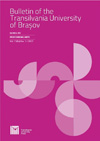The Genesis of GENDY3. The Creative Process that Led to Xenakis' Opus Summum
The Genesis of GENDY3. The Creative Process that Led to Xenakis' Opus Summum
Author(s): Peter HoffmannSubject(s): Fine Arts / Performing Arts, Music, ICT Information and Communications Technologies
Published by: Editura Universitatii Transilvania din Brasov
Keywords: Xenakis; electroacoustic music; computer music; algorithmic composition; sound synthesis;
Summary/Abstract: The present study is experimental research, conducted on children aged 6-7 years, included in preparatory classes, based on the learning and implementation of the theoretical and practical information with the help of “live demonstration” and “iconographic demonstration”, therefore relying on imitation. In Physical Education, the quickest and easiest way for children to learn is through imitation. The analysis of the results showed that in the experimental group the use of the “live demonstration" leads to a greater increase in the number of pupils who can memorise and perform more related items than in the control group, which used the iconographic demonstration.Gendy 3 (1991) by Iannis Xenakis is the culmination of his lifelong quest for an automated (i.e. algorithmic) music. About 20 minutes of digital sound are computed directto- disk and presented more or less as such to the public. Therefore, Gendy 3 demonstrates the machine computability of a work of art. Officially, there is only one Gendy 3 in Xenakis' catalogue of works. However, before the world premiere of Gendy 3 on 11/17/1991 in Metz, France, Xenakis presented a proto version called GENDY301 at ICMC Montreal on 10/18/1991, which is a similar but completely different piece. Moreover, an uncut “raw” version (I call it “GENDY3”) can be obtained by re-executing Xenakis' own algorithm. It contains 75 seconds more music than Gendy 3. And finally, Xenakis' algorithm also allows creating a 16-track version by generating all of its 16 layers of sound separately. These 4 versions (2 by Xenakis, 2 by the author), taken together, help to retrace the creative process that led to one of the most remarkable pieces of electroacoustic music to date.
Journal: Bulletin of the Transilvania University of Braşov, Series VIII: Performing Arts
- Issue Year: 15/2022
- Issue No: 1
- Page Range: 123-140
- Page Count: 18
- Language: English

